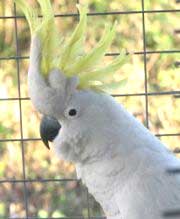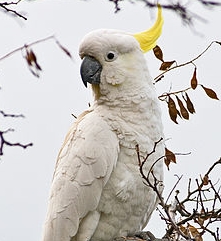Genus: Cacatua – Species: galerita.
SUBSPECIES: there is only four recognised subspecies. Only two are natives of just Australia.
- Cacatua galerita galerita; is found in eastern Australia and is the most common in captivity. They have a white eye ring, a paler yellow colour around the ear coverts, and shorter crest feathers.
- Cacatua galerita fitzroyi; Fitzroy Cockatoo is located in north and north-western Australia, They have pale blue eye rings, brighter yellow colour to their ear covert and longer crest feathers. They are the most rare in captivity.
- Cacatua galerita triton; Triton Cockatoo, is considered to be very intelligent and the easiest to train. For this reason they are often used to perform in bird shows.
- Cacatua galerita eleonora; The Eleonora Cockatoo the smallest of the Greater Sulphur Crested Cockatoos and is also known as the Medium Sulphur Crested Cockatoo.

Australian Sulphur Crested Cockatoo - Cacatua galerita. This picture was taken by Amos T Fairchild and located at wikipedia.org site
PHYSICAL DESCRIPTION:
The Sulphur Crested Cockatoos is an impressive large white parrot with a striking yellow crest. They have a lovely light tint of yellow just below their eyes near the back of their cheek area. They have a very fine powder that waterproof their feathers. They have yellow feathers under their wings and tail. Both their beak and feet are dark, almost black.
Their distinguishing crest is a unique characteristic, which is exclusive to only cockatoos, and their much smaller cousin, the cockatiel. Their crest is used as a form of communication and is often raised to express distress, fear or as a warning to stay away, but this is not always the case. They will also display their crest in excitement and during play. The crest is also used during courting displays.
The females can sometimes be identified through the colour of their eyes, they tend to have slightly lighter, reddish/brown tinge to their iris. However this is not a consistent occurrence and many females will have the same black eye colouring of their male counterparts. The size of the head can sometimes provide a clue as to the sex of the parrot as the adult male generally has a slightly larger head. The adolescent birds resemble the adults and it is particularly difficult to tell the difference between a male and female. The only truly accurate way to determine the sex of your parrot is through DNA testing.
SIZE: Length up to about 50 cm, weighting around 850 grams
DISTRIBUTION & HABITAT: The Sulphur-crested Cockatoo is native to Australia and can be found in Tasmania, Victoria, New South Wales, and Queensland, the Northern Territory and Western Australia. Many birds that have escape or have been deliberately released are now living in areas where they do not normally occur, such as Perth and in New Zealand
They are very social birds and will congregate in very large groups with numbers in the hundreds, they tend to disperse into smaller flocks for ground feeding and reunite in the evening for roosting. The noise of hundreds of cockatoo loudly shrieking as the fly can be almost deafening. They are generally found in a variety of timbered habitats area close to a water source and they tend to stay in the same area all year round. The Cockatoo has been very successful in adapting too many man made environments, often becoming a bit of a pest, due to the damage they cause by chewing on homes and other wooden structures. The Cockatoo is often seen feeding in large flocks on the ground along roadsides and highways. with one or more members of the group watching for danger from a nearby perch.
STATUS: Protected species under the Australian Commonwealth Law.
DIET: The Sulphur-crested Cockatoo feeds mainly on seeds, grains, nuts, fruits, insects and insect larvae and roots.
Many sites recommend a combination of small parrot and/or Cockatiel seed mix, striped sunflower seeds (not too many), oats, Canary Seed, and Millets, as a basis for their seed diet, while other sites recommend parrot pellets or a combination of both. One site recommends coating the seed mix with Wheat Germ Oil to provide vitamins and prevent egg binding in their birds.
What ever your choice, make sure that 50% of your Cockatoo’s diet is a variety of clean fresh fruits and vegetables, sprouts, flowers, berries and nectar. It is very important that any uneaten or spoilt fruit is removed as soon as possible, through out the day to prevent contamination and fermentation, especially during hot humid weather. Their diet needs to be balanced and interesting. You should also supplement their diet with nuts, soaked and sprouted seed, seeding grasses, seed heads, and even egg and biscuit mix.
Cockatoos need a source of protein, which can be obtained with insectivore mixes, insect larvae, mealworms, other grubs or a protein powder. You also need to maintain adequate levels of vitamins and minerals, there are many types of mineral and vitamin blocks available. I use a mineral perch. Don’t forget the benefits of cuttlefish and shell grit. They also spend a lot of time on the ground scratching around in dirt so it is imperative that they are wormed regularly.
Cockatoos are also known to engage in geophagy, which is the practice of eating clay to detoxify their food.
Eucalyptus branches, leaves and flowers are a natural source of food but when placed throughout their enclosure they also become an important source of entertainment and exercise. Mental stimulation is extremely important for all birds in captivity. They also enjoy a dish of water for bathing or they will try to use their drinking water Change their water every day, and frequently clean their feeding bowls, toys, perches and cage or aviary to prevent contamination

Australian Sulphur Crested Cockatoo - Cacatua galerita. This picture was taken by Mfunnell and located at wikipedia.org site
COMPATIBILITY: The Sulphur-crested Cockatoo is relatively non aggressive and can sometimes be housed with other parrots of a similar size, but only in suitable large enclosures and outside of the breeding season.
TEMPERAMENT: The Sulphur-crested Cockatoo are extremely intelligent and even considered by some to be one of the most intelligent parrots. They are energetic, playful, mischievous and extremely curious birds which can make them naturally entertaining and funny companions. Sulphur Crested Cockatoos can be great acrobats and many have been trained to do an amazing range of tricks.
PET STATUS: The Sulphur Crested Cockatoo can make wonderful companions for gentle, kind people who have loads of patients and heaps of time to spend bonding and entertaining this extremely intelligent bird.
Your Sulphur-crested Cockatoo can become an extremely affectionate, loyal and loving companion. They can also bond excessively to one particular person, and may even become extremely jealous if other people or birds go near their special human. They may come to see that human as a mate/spouse and can become very aggressive and lash out at anyone coming too near.
Your intelligent Sulphur-crested Cockatoo will require continuous mental stimulation and their strong social nature requires a great deal of ongoing attention and affection. If they are deprived of mental stimulation and/or attention and affection WILL become depressed and develop neurotic behaviours, including screeching, feather plucking and biting , just to name a few.

Australian Sulfur Crested Cockatoo - Cacatua galerita This picture was taken by Anneke anneke and located at wikipedia.org site
TOYS: Cockatoos love to chew and destroy things, so it is really important to provide plenty of toys and objects for chewing, mental stimulation and to maintain wear on their large beaks and claws.
There are so many toys and objects available, such as swings, play gyms, cuttlefish, wooden and hard plastic toys, leather, cardboard, rope toys, wooden balls and bells. Make sure that you provide toys that you bird can pick up with their feet and beak as well as hanging toys. Make sure that all your toys are safe, and are also hung or placed in a safe location, to prevent any injury, accidental entrapment or hanging. Also treat them with vegetable flavoured and shaped wood chews, seed bells and various favourite foods serve up all around their enclosure to encourage foraging, exercise and mental stimulation.
You should include numerous and various sized perches, such as wooden perches, soft pliable perch, mineral perches and various sized branches. Natural branches offer the best variety in size, allowing them to maintain fitness and strength in their feet. I like to place fresh, leafy and/or seeded branches from Banksias, Grevilleas and Bottlebrushes, and try to create a maze effect, for simulation. seed bells are an added snack and chew bonus. Once again, make sure that all perches and branches are safe, and hung or placed in a safe location, to prevent any injury, accidental entrapment or hanging.
ABILITY TO TALK: Both the male and female Sulphur-crested Cockatoo can become wonderful talkers and fantastic sound mimickers, however many consider the male to have a better tendency to becoming a more avid conversationalist. I personal believe that it has more to do with the individual bird’s personality and the amount of time and patience that you share with your cocky while you help develop their vocabulary.
LEVEL OF NOISE: The Sulphur-crested Cockatoo is generally a quite parrot throughout most of the day but during early morning and dusk they release an exceptionally loud and penetrating screech that if you are lucky will only last through a few short outbursts. However there are always exceptional individuals who screech all throughout the day. The screech of a Sulphur-crested Cockatoo can be deafening and can really make life extremely uncomfortable for nearby neighbours.
References: (Viewing date –4th July 2008)
http://www.birdsnways.com/mowen/sc2.htm
http://en.wikipedia.org/wiki/Sulphur-crested_Cockatoo
http://www.centralpets.com/animals/birds/parrots/prt801.html
http://www.birdsinbackyards.net/finder/display.cfm?id=48
http://www.birdworld.com.au/bw_bird_index.php?birdid=galerita%20&birdg=Cacatua
http://www.faunanet.gov.au/wos/factfile.cfm?Fact_ID=433
http://exoticpets.about.com/od/cockatoos/p/cockatoos.htm
—————————————————————-
Please contact me, using the comments, if you would like to use them so were can discuss any arrangements. Copyright (c) 2008 All Images are covered by copyright law. Images on this page have been sourced from others sites and may have specific copyright, please contact them in relation to their use. Each photo has a link back to the original site. Some people a kind enough to allow their images to be displayed in blogs or emails but they still maintain copyright ownership.


